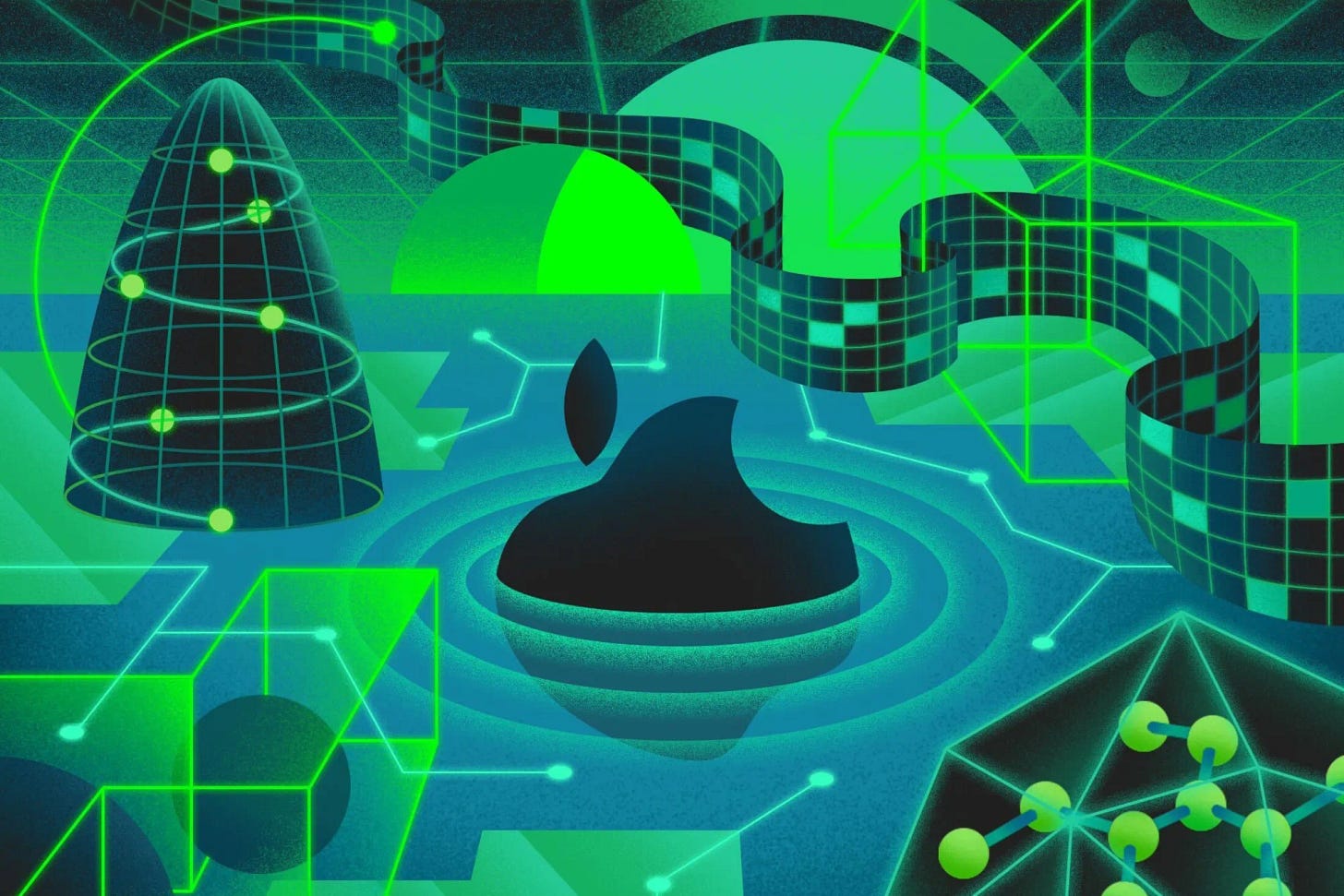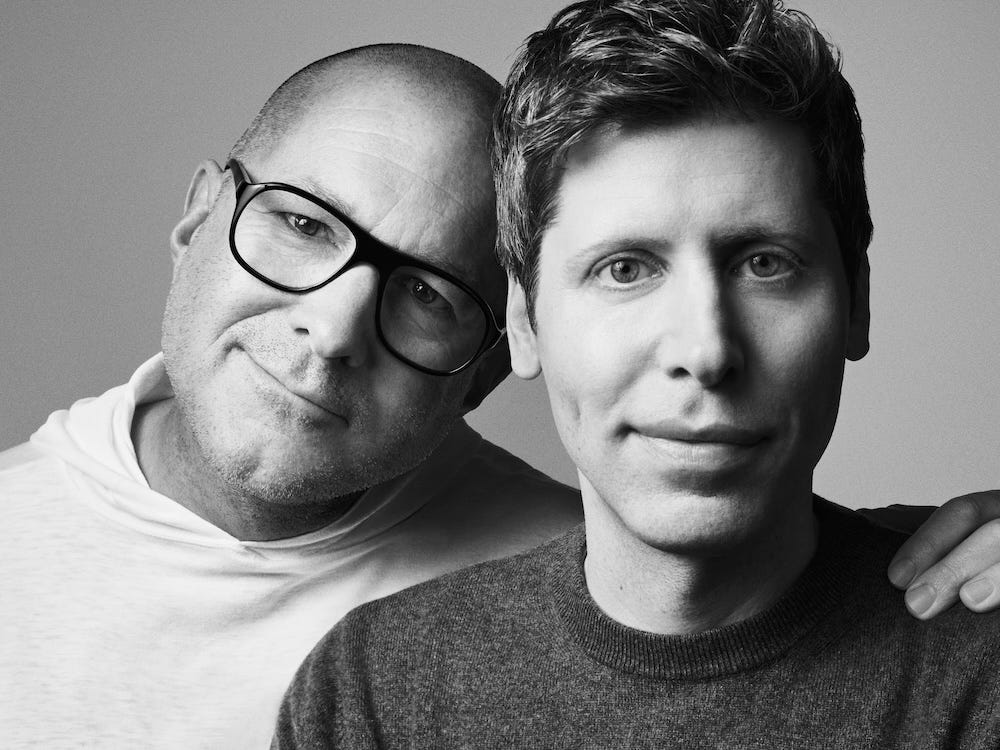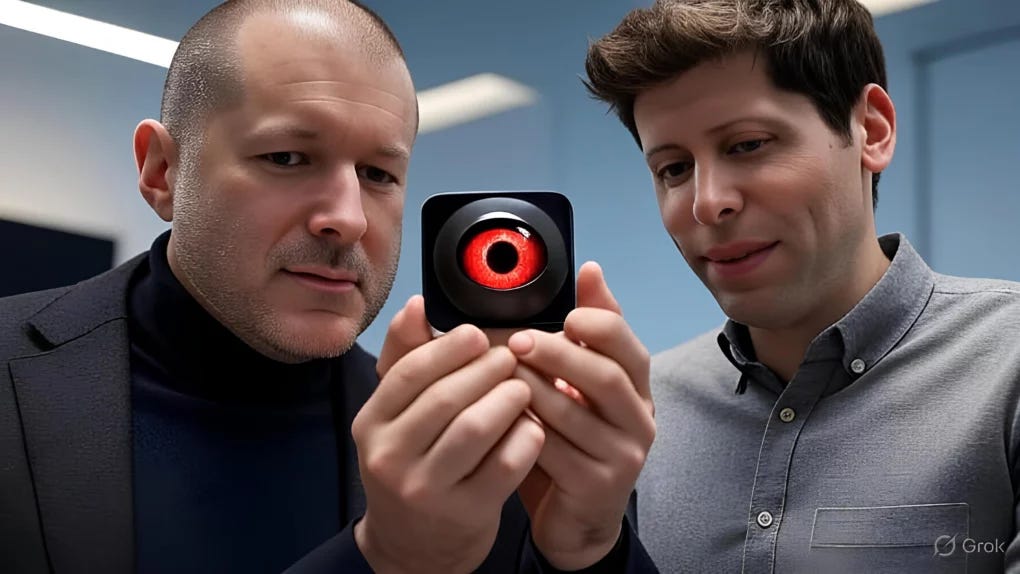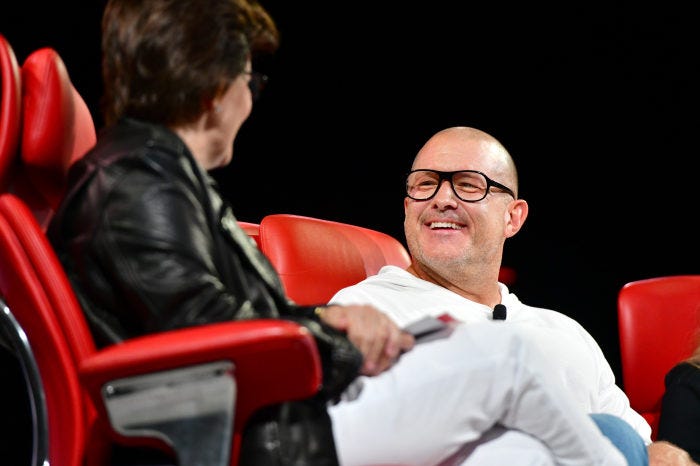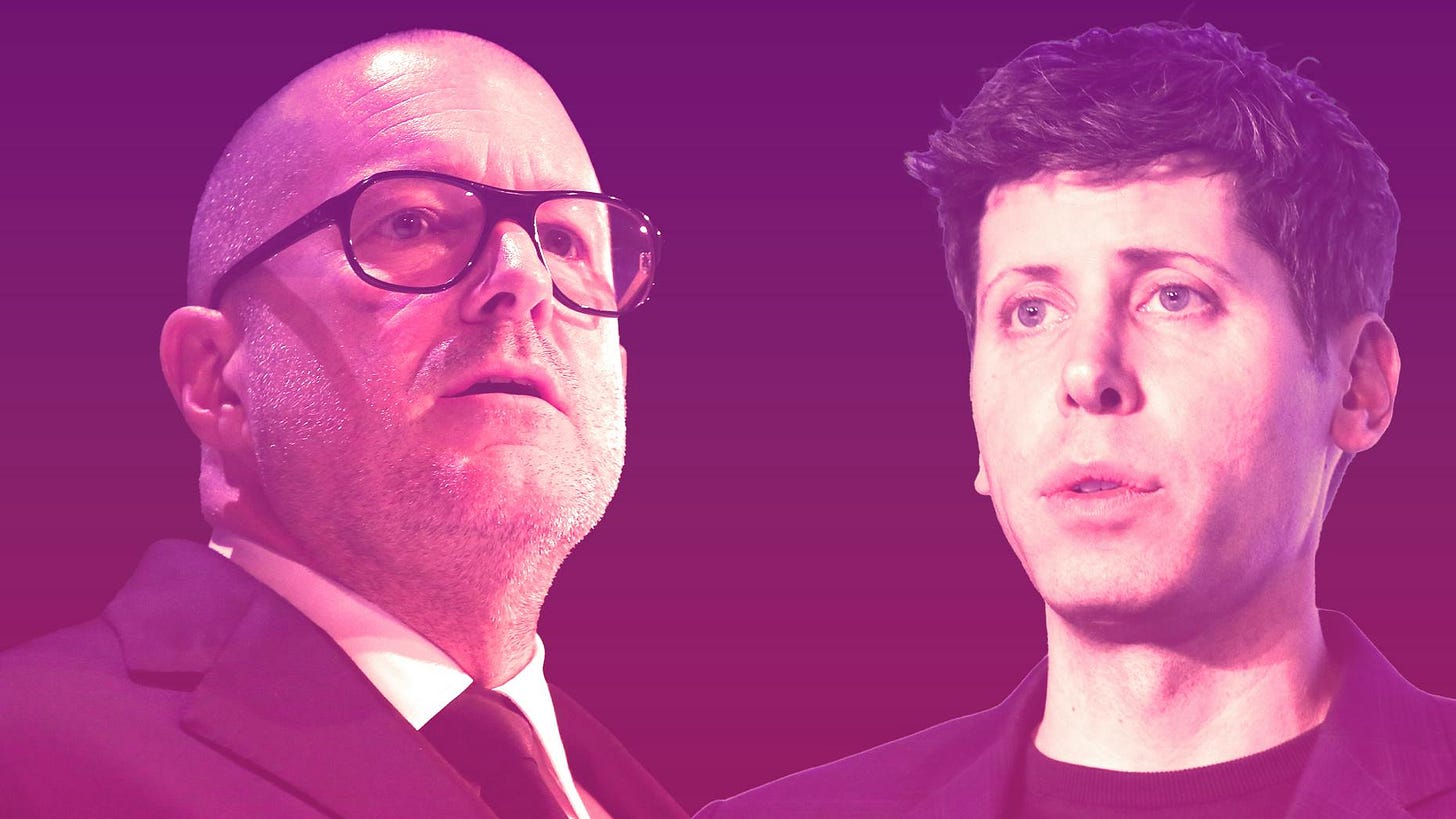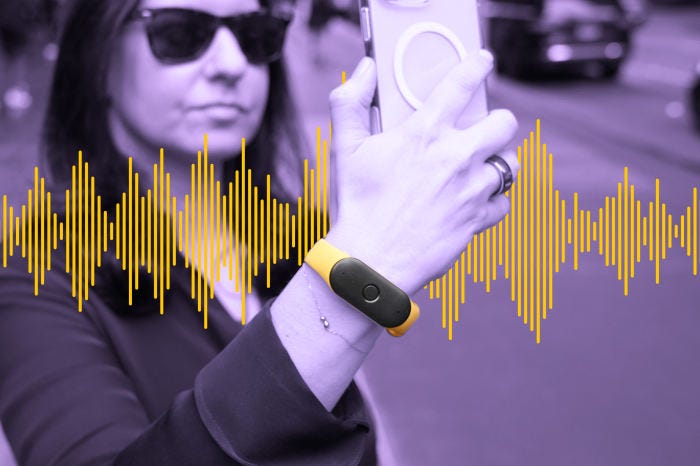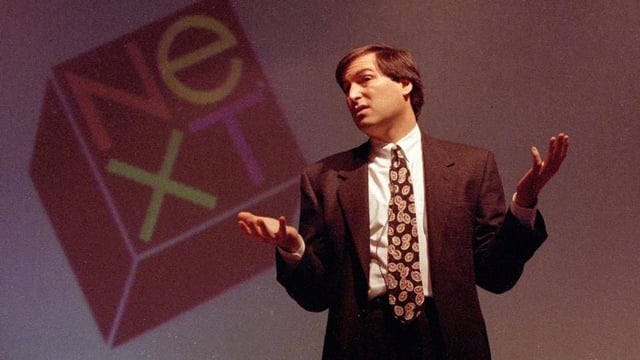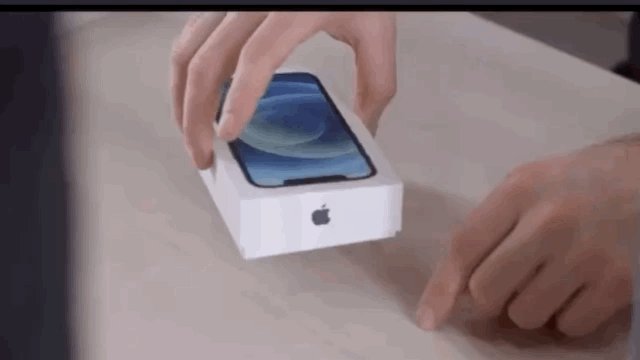
AI: OpenAI's 'Sam/Jony' AI device now more real. RTZ #728
There will soon be another exciting gadget box to open with high anticipation next year. But this one won’t be from Apple. But it will be designed by its iconic alum Jony Ive. And it will have some sort of ‘AI Device’, yet to be perfected. Potentially as important as the iPhone.
After almost two years of speculation, Sam Altman and Jony Ive have decided to throw in their AI lot together to design how the world will experience OpenAI’s fountain of AI products and servcies.
The $6.5 billion acquisition/merger between OpenAI and Lovefrom/io Products, also promises an AI device of some sort next year. With Apple’s iconic iPhone/Macbook and other product designer throwing in with OpenAI, the gauntlet is of course down for Apple. While it’s already feeling white hot pressure to get its Siri/Apple Intelligence act together.
That aside, the AI industry is also racing to figure out the various ways the world can do AI things at scale. Beyond computers, laptops,and smartphones. Much expectation in the air for AI wearables from Smart Glasses to Voice devices in the form of pins and bracelets being tested, along with Apple’s efforts with AI powered Airpods, being experimented with today and tomorrow.
The OpenAI announcement on the merger was well done with a message and video. Titled ‘Sam & Jony introduce io’, it explains:
“May 21, 2025
This is an extraordinary moment.
Computers are now seeing, thinking and understanding.
Despite this unprecedented capability, our experience remains shaped by traditional products and interfaces.
Two years ago, Jony Ive and the creative collective LoveFrom, quietly began collaborating with Sam Altman and the team at OpenAI.
A collaboration built upon friendship, curiosity and shared values quickly grew in ambition. Tentative ideas and explorations evolved into tangible designs.
The ideas seemed important and useful. They were optimistic and hopeful. They were inspiring. They made everyone smile. They reminded us of a time when we celebrated human achievement, grateful for new tools that helped us learn, explore and create.
It became clear that our ambitions to develop, engineer and manufacture a new family of products demanded an entirely new company. And so, one year ago, Jony founded io with Scott Cannon, Evans Hankey and Tang Tan.
We gathered together the best hardware and software engineers, the best technologists, physicists, scientists, researchers and experts in product development and manufacturing. Many of us have worked closely for decades.
The io team, focused on developing products that inspire, empower and enable, will now merge with OpenAI to work more intimately with the research, engineering and product teams in San Francisco.
As io merges with OpenAI, Jony and LoveFrom will assume deep design and creative responsibilities across OpenAI and io.
We could not possibly be more excited.
Sam & Jony”
The video is also worth watching. One can alnost feel the San Francisco sun and wind in the face.
So what does the device look like? What is its form and function?
So far there’re only guesses. AI generated and otherwise. And lots of unending speculation.
The Information states:
“It’s anyone’s guess what the AI devices io and OpenAI are building might look like. Some early potential designs include a handheld, screen-less device that consumers can control with their voice, said the person who’s talked with employees. Other ideas we’ve heard include AI-enabled household devices, like a lamp, another person involved told us. (The “screen-less” detail is intriguing, given Ive’s past criticisms of how consumers have become seemingly addicted to looking at their iPhones.)”
“Whatever the device is, OpenAI will need to do some serious beefing up of its supply chain connections and knowledge to be able to match the prowess of longstanding hardware manufacturers like Apple.”
The WSJ reports exclusively on an OpenAI meeting with Sam and Jony:
“Altman and Ive offered a few hints at the secret project they have been working on. The product will be capable of being fully aware of a user’s surroundings and life, will be unobtrusive, able to rest in one’s pocket or on one’s desk, and will be a third core device a person would put on a desk after a MacBook Pro and an iPhone.”
“The Journal earlier reported that the device won’t be a phone, and that Ive and Altman’s intent is to help wean users from screens. Altman said that the device isn’t a pair of glasses, and that Ive had been skeptical about building something to wear on the body.”
“Ive referred to “a new design movement.” Altman said it would amount to a “family of devices,” bringing up his fondness for how Apple has long integrated its hardware and software offerings.”
Tech industry analyst Ming-Chi Kuo reports additional details from supply chain sources:
“My industry research indicates the following regarding the new AI hardware device from Jony Ive’s collaboration with OpenAI: “
1. “Mass production is expected to start in 2027. “
2. “Assembly and shipping will occur outside China to reduce geopolitical risks, with Vietnam currently the likely assembly location.“
3. “The current prototype is slightly larger than the AI Pin, with a form factor as compact and elegant as an iPod Shuffle. The design and specifications may change before mass production.”
4. “One of the intended use cases is wearing the device around the neck.“
5. “It will have cameras and microphones for environmental detection, with no display functionality. “
6. “It is expected to connect to smartphones and PCs, utilizing their computing and display capabilities.”
“In my view, one of OpenAI’s motives for announcing its collaboration with Jony Ive now is likely to shift market focus from recent Google I/O. Google’s ecosystem and AI integration, showcased in the I/O keynotes, pose a challenge that OpenAI currently struggles to address. As a result, OpenAI is leveraging a new narrative to redirect attention.”
“That said, AI integrated into real-world applications, often termed “physical AI,” is widely recognized as the next critical trend. While the success of the Jony Ive-OpenAI partnership remains uncertain, it clearly aligns with this trend. This partnership also recalls Alan Kay’s well-known adage: “People who are really serious about software should make their own hardware.”
But the ambitions are high in terms of scale of production and sales as the WSJ reports:
“Jony Ive, laying out plans to ship 100 million AI “companions” that he hopes will become a part of everyday life.”
“Employees have “the chance to do the biggest thing we’ve ever done as a company here,” Altman said after announcing OpenAI’s plans to purchase Ive’s startup, named io, and give him an expansive creative and design role. Altman suggested the $6.5 billion acquisition has the potential to add $1 trillion in value to OpenAI, according to a recording reviewed by The Wall Street Journal.”
So for now we will have a global, continuous game of the proverbial ‘blind men and an elephant’ on what the device eventually ends up being. And of course other devices by peers to compete in the world of ‘Physical AI’. With all their social and regulatory ‘Trust’ boundaries I’ve discussed before. And the generational differences in mainstream receptivity for AI in our daily lives.
The NY Times has much more on how all this came to be in “OpenAI Unites With Jony Ive in $6.5 Billion Deal to Create A.I. Devices”:
“OpenAI said it was buying IO, a start-up founded by Mr. Ive, the designer of the iPhone, to usher in a new era of artificial intelligence hardware.”
“The rise of artificial intelligence has profoundly altered the technology world in recent years, upending how software is created, how people search for information, and how images and videos can be generated — all with a few prompts to a chatbot.”
“What the technology has yet to do, though, is find a preferred form in a physical, everyday gadget. A.I. largely remains the domain of an app on phones, despite efforts by start-ups and others to move it into devices.”
“Now OpenAI, the world’s leading A.I. lab, is taking a crack at that riddle.”
“On Wednesday, Sam Altman, OpenAI’s chief executive, said the company was paying $6.5 billion to buy IO, a one-year-old start-up created by Jony Ive, a former top Apple executive who designed the iPhone. The all-stock deal, which effectively unites Silicon Valley royalty, is intended to usher in what the two men call “a new family of products” for the age of artificial general intelligence, or A.G.I., which is shorthand for a future technology that achieves human-level intelligence.”
“The deal, which is OpenAI’s biggest acquisition, will bring in Mr. Ive and his team of roughly 55 engineers and researchers. LoveFrom will assume creative and design responsibilities across OpenAI and build hardware that helps people better interact with the technology.”
“In a joint interview, Mr. Ive and Mr. Altman declined to say what such devices could look like and how they might work, but they said they hoped to share details next year. Mr. Ive, 58, framed the ambitions as galactic, with the aim of creating “amazing products that elevate humanity.”
“We’ve been waiting for the next big thing for 20 years,” Mr. Altman, 40, added. “We want to bring people something beyond the legacy products we’ve been using for so long.”
“Mr. Altman and Mr. Ive are effectively looking beyond an era of smartphones, which have been people’s signature personal device since the iPhone debuted in 2007. If the two men succeed — and it is a very big if — they could spur what is known as “ambient computing.” Rather than typing and taking photographs on smartphones, future devices like pendants or glasses that use A.I. could process the world in real time, fielding questions and analyzing images and sounds in seamless ways.”
“Mr. Altman had invested in Humane, a company that pursued this kind of vision with the creation of an A.I. pin. But the start-up folded not long after its product flopped.”
“In their interview, Mr. Ive expressed some misgivings with the iPhone and said that had motivated him to team up with Mr. Altman.
“I shoulder a lot of the responsibility for what these things have brought us,” he said, referring to the anxiety and distractions that come with being constantly connected to the computer in your pocket.
“Mr. Altman echoed the sentiment. “I don’t feel good about my relationship with technology right now,” he said. “It feels a lot like being jostled on a crowded street in New York, or being bombarded with notifications and flashing lights in Las Vegas.” He said the goal was to leverage A.I. to help people make some sense of the noise.”
“As part of the deal, Mr. Ive and his design studio, LoveFrom, will remain independent and continue to work on projects separate from OpenAI. Scott Cannon, Evans Hankey and Tang Tan, who also founded IO with Mr. Ive, will become OpenAI’s employees and report to Peter Welinder, a vice president of product, who will oversee the IO division. The acquisition is a significant windfall for Mr. Ive.”
“OpenAI already owned a 23 percent stake in IO as part of an agreement between the two companies at the end of last year, two people with knowledge of the deal said, so it is now paying around $5 billion to fully acquire the start-up. OpenAI separately has a Start-Up Fund that invested in Mr. Ive’s start-up last year, the people said. The deal is subject to regulatory approval.”
“(The New York Times has sued OpenAI and its partner, Microsoft, for copyright infringement regarding news content related to A.I. systems. OpenAI and Microsoft have denied the claims.)”
“OpenAI set off the A.I. boom in late 2022 when it released the ChatGPT chatbot. In March, the start-up completed a $40 billion funding that valued it at $300 billion, making it one of the world’s most valuable private companies. The fund-raising round was led by the Japanese conglomerate SoftBank.”
“As it has grown, OpenAI has struggled to adopt a new corporate structure. Founded in 2015 as a nonprofit organization, the A.I. lab has been trying to reinvent itself as a for-profit company so it can more easily raise money from investors. If it does not restructure by the end of the year, SoftBank could halve its investment in the company.”
“That makes the billions that OpenAI is paying for Mr. Ive’s start-up a steep outlay, especially as the start-up is also unprofitable. Building the technology that powers ChatGPT and other services is enormously expensive, and OpenAI is under pressure to raise revenues.”
“OpenAI expects about $3.7 billion in sales this year and about $11.6 billion next year, according to financial documents reviewed by The Times. The company is also in talks to acquire Windsurf, an A.I.-powered programming tool, for about $3 billion.”
“Asked how OpenAI would find the money to buy IO, Mr. Altman said the press worried about OpenAI’s funding and revenues more than the company did.”
“We’ll be fine,” he said. “Thanks for the concern.”
“The deal came together after Mr. Ive, a protégé of the Apple founder Steve Jobs who designed the iPod and many other products, became intrigued by A.I. He felt somewhat lost after leaving Apple in 2019, he said, and was eager to find his next act.”
Two years ago, Charlie Ive, one of his 21-year-old twin sons, told him about ChatGPT, Mr. Ive said. Curious about his son’s excitement over the chatbot, Mr. Ive connected with Mr. Altman. They became friends.
“Mr. Ive said he was so enamored with the technology that he founded IO last year with several peers to conceptualize new hardware products suited to A.I. By early this year, it became clear that he and Mr. Altman wanted to form a partnership to work on a new generation of devices, he said.”
“Mr. Ive said the partnership was being led not by a fiscal imperative but from a place of building products that “benefit humanity.”
“I believe everything I’ve done in my career was leading to this,” he said.”
The WSJ and Wired both have separate takes worth reading.
In a piece I did on Sam Altman and various Generations using AI, a few days ago, where he talks about Voice and GUIs together at the 19 minute mark. My nephew Neal and I discussed this from the Gen Z and Boomer perspective on this possible blending.
It remains to be seen if this blending of AI Voice and GUI is in the cards for the new product Sam and Jony could be dreaming up. Note that they’re reportedly way of too much screen time distracting folks from being present in their daily lives. So lots of design, user interface and experience (UI/UX) challenges integrating AI Voice into AI at large.
Along with the opportunities of course.With lots of companies large and small trying their hand at the next big thing.
But the big take away is that the race to figure out the better ways to experience and use AI in its various forms is underway. And OpenAI has emphatically thrown its hat into the ring. With Jony Ive leading all design at OpenAI, and Sam Altman kinda sliding into the ‘Steve Jobs’ role. For OpenAI’s next major venture.
Alongside Apple, Amazon, Meta, Google, and many other companies large and small. It’s going to be an interesting 2026 for AI devices in this AI Tech Wave.
Longer term, there’s complex chess games in play here, with lots of discussion around the impact of Jony Ive working with Sam and OpenAI impacting Apple in its Ai ambitions longer term.
Who knows, history could rhyme again in the form of a future Apple buying the Sam and Jony team at OpenAI to cement its AI software, infrastructure and device strategy in a manner similar to Apple buying Steve Jobs’ Next venture in the 1990s to form the basis of Apple’s comeback in the PC/Internet era.
The numbers would be manageable given the relative sizes. And that worked out relatively well for all sides. Maybe it can all rhyme again.
The AI device game is just getting started at scale. Stay tuned.
(NOTE: The discussions here are for information purposes only, and not meant as investment advice at any time. Thanks for joining us here)

